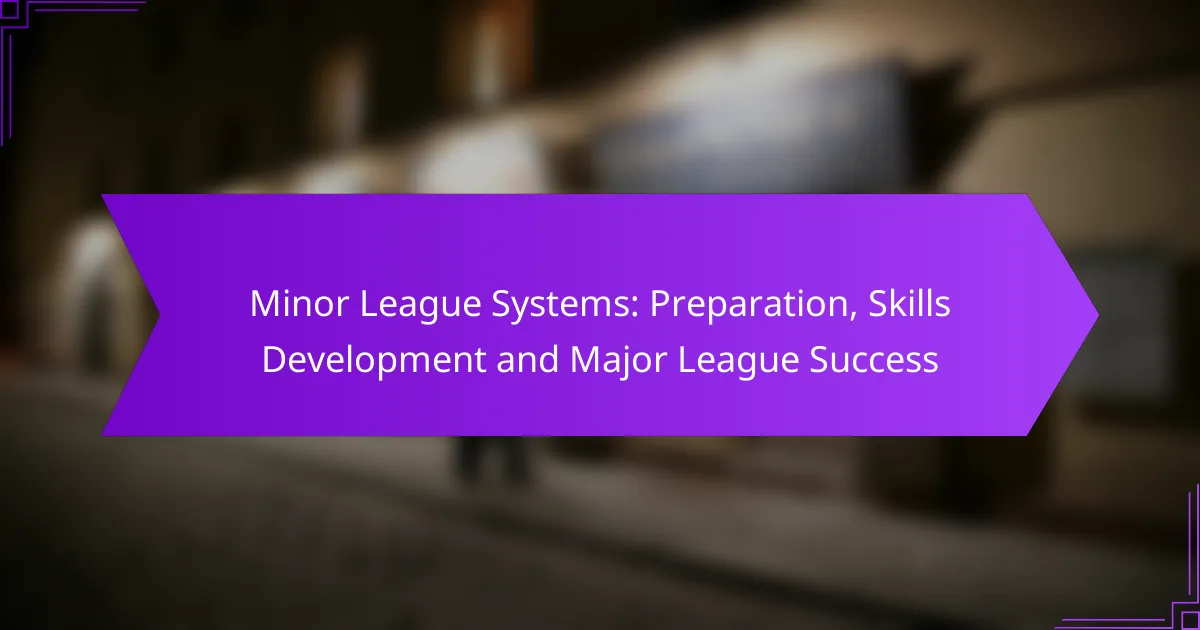Minor league systems are vital for nurturing baseball talent, offering structured development opportunities that equip players with essential skills for Major League success. Through specialized coaching and competitive play, these systems enhance abilities in hitting, pitching, defense, and base running while fostering the mental resilience needed to thrive at the highest level. Key factors such as player mindset, adaptability, and team dynamics play a significant role in shaping a player’s journey from the minors to the majors.

How do Minor League Systems prepare players for Major League success?
Minor league systems play a crucial role in preparing players for Major League success by providing structured development opportunities, specialized coaching, and competitive environments. These systems focus on enhancing skills, building experience, and fostering the mental resilience necessary for the challenges of the Major Leagues.
Player development programs
Player development programs in minor leagues are designed to enhance the skills and abilities of athletes through tailored training regimens. These programs often include a mix of on-field practice, strength and conditioning, and mental skills training. Players typically progress through various levels, allowing them to refine their skills at each stage before advancing to the Major Leagues.
For example, a player might start in a rookie league, focusing on basic skills, before moving to higher levels where they face more advanced competition and receive more specialized coaching. This gradual progression helps players adapt to the increasing demands of professional baseball.
Coaching strategies
Coaching strategies in minor league systems emphasize individualized attention and skill-specific training. Coaches often assess players’ strengths and weaknesses to create personalized development plans. Techniques such as video analysis and one-on-one instruction are commonly used to enhance player performance.
Moreover, coaches in the minor leagues often focus on building a player’s mental game, teaching them how to handle pressure and maintain focus during games. This holistic approach prepares players not just physically, but also mentally for the rigors of Major League play.
Training facilities
Training facilities in minor league systems are equipped with essential resources to support player development. These facilities typically include batting cages, pitching mounds, weight rooms, and video analysis tools. Access to high-quality training environments allows players to practice effectively and develop their skills in a controlled setting.
Many minor league teams invest in modern technology to track player performance and provide feedback, which is crucial for continuous improvement. Facilities may also offer rehabilitation services to help players recover from injuries, ensuring they remain competitive and ready for advancement.
Performance analytics
Performance analytics play a significant role in minor league systems by providing data-driven insights into player performance. Teams utilize various metrics, such as batting averages, on-base percentages, and pitching statistics, to evaluate player progress and identify areas for improvement.
By analyzing performance data, coaches can make informed decisions about player development strategies and game strategies. This analytical approach helps players understand their performance trends, allowing them to make necessary adjustments and enhance their chances of success in the Major Leagues.

What skills are developed in Minor League Systems?
Minor League Systems focus on developing essential baseball skills that prepare players for success in Major League Baseball (MLB). These skills include hitting, pitching, defense, and base running, each crucial for a player’s overall performance and career advancement.
Hitting techniques
Hitting techniques in Minor League Systems emphasize proper stance, swing mechanics, and pitch recognition. Players learn to adjust their approach based on pitch types and game situations, which is vital for improving batting averages and on-base percentages.
Common drills include tee work, soft toss, and live batting practice, allowing players to refine their timing and hand-eye coordination. Coaches often focus on developing a player’s ability to hit to all fields, enhancing their versatility at the plate.
Pitching mechanics
Pitching mechanics are critical in Minor League Systems, where players learn the fundamentals of delivery, arm action, and follow-through. Proper mechanics help reduce injury risk while maximizing pitch effectiveness and velocity.
Players practice various pitch types, including fastballs, curveballs, and changeups, focusing on grip and release point. Consistent repetition and feedback from coaches are essential for mastering these skills and developing a reliable pitching repertoire.
Defensive skills
Defensive skills training in Minor League Systems covers fielding techniques, positioning, and situational awareness. Players work on catching ground balls, fly balls, and making accurate throws to bases, which are crucial for preventing runs and securing outs.
Drills often include infield and outfield practice, emphasizing footwork and quick decision-making. Understanding defensive alignments and communication with teammates is also a key component of training, ensuring players can effectively execute plays during games.
Base running
Base running skills are developed through drills that focus on speed, agility, and situational awareness. Players learn to read pitchers, take leads, and make smart decisions on when to steal or advance on hits.
Key aspects include proper technique for rounding bases and sliding safely. Coaches emphasize the importance of timing and awareness, helping players understand how to capitalize on defensive mistakes and maximize scoring opportunities.

What are the key factors for success in Minor League Systems?
The key factors for success in Minor League Systems include player mindset, adaptability to coaching, and team dynamics. These elements significantly influence a player’s development and their potential transition to Major League Baseball.
Player mindset and resilience
A strong player mindset and resilience are crucial for thriving in Minor League Systems. Players often face challenges such as performance pressure, competition for roster spots, and the need for continuous improvement. Developing mental toughness helps players navigate these obstacles and maintain focus on their goals.
Resilience can be cultivated through practices like visualization, goal-setting, and seeking feedback. Players should embrace setbacks as learning opportunities, which can enhance their long-term success in the sport.
Adaptability to coaching
Adaptability to coaching is essential for players in Minor League Systems. Coaches often have different styles and philosophies, and players must be open to adjusting their techniques and strategies. This flexibility can lead to improved performance and a better understanding of the game.
Players should actively engage with their coaches, asking questions and applying feedback. Embracing a growth mindset allows players to learn from various coaching approaches, which can be beneficial as they progress toward Major League play.
Team dynamics
Team dynamics play a significant role in the success of players within Minor League Systems. A cohesive team environment fosters collaboration and support, which can enhance individual and collective performance. Strong relationships among teammates contribute to a positive atmosphere that encourages growth.
To improve team dynamics, players should focus on communication, trust-building, and shared goals. Participating in team-building activities can also strengthen bonds and create a more unified approach to achieving success on the field.

How do Minor League Systems compare across the United States?
Minor league systems in the United States vary significantly in terms of structure, training methods, and overall effectiveness in developing players for the major leagues. These differences can impact player progression and the success of franchises in nurturing talent.
Regional differences in training
Training practices in minor league systems can differ widely across regions due to local resources, coaching philosophies, and climate. For instance, teams in warmer climates may have longer outdoor training seasons, while those in colder areas often rely on indoor facilities during winter months.
Additionally, some regions emphasize specific skills based on the local talent pool. For example, teams in the Southeast might focus on speed and agility, reflecting the athleticism of players from that area, while teams in the Midwest may prioritize pitching and defensive skills.
Franchise investment levels
The level of investment by franchises in their minor league systems can greatly influence player development. Teams with higher budgets often provide better facilities, coaching staff, and training programs, leading to improved player outcomes. Conversely, franchises with limited resources may struggle to offer the same level of support.
Investment levels can also affect the number of minor league affiliates a franchise maintains. Teams with greater financial backing may operate multiple affiliates, allowing for a more extensive player development pipeline, while others might only have a single affiliate, limiting their ability to nurture talent effectively.
Player recruitment practices
Recruitment practices for minor league systems vary by franchise and region, impacting the quality and diversity of talent. Some teams prioritize drafting players from college programs, while others focus on international scouting to find emerging talent. This can lead to differences in player profiles and skill sets within a system.
Additionally, teams may employ different strategies for signing free agents or acquiring players through trades. A franchise that actively seeks out high-potential players may build a stronger minor league system, while one that is more conservative in its approach may miss out on valuable talent.

What role do analytics play in player development?
Analytics play a crucial role in player development by providing data-driven insights that help teams assess player performance and potential. By analyzing various metrics, teams can tailor training programs and strategies to enhance skills and increase the chances of success in the Major Leagues.
Data-driven decision making
Data-driven decision making involves using analytics to inform choices related to player training, scouting, and game strategy. Teams collect data on player performance, including batting averages, pitch velocities, and defensive metrics, to identify strengths and weaknesses. This information allows coaches to create personalized development plans that target specific areas for improvement.
For example, if a player struggles with hitting against left-handed pitchers, analytics can reveal patterns in their performance. Coaches can then design targeted drills to help the player improve in that area. By focusing on measurable outcomes, teams can maximize the effectiveness of their training efforts.
It is essential to balance data with qualitative assessments from coaches and scouts. While analytics provide valuable insights, human intuition and experience remain vital in understanding player dynamics and potential. Teams should ensure that data complements, rather than replaces, traditional evaluation methods.



